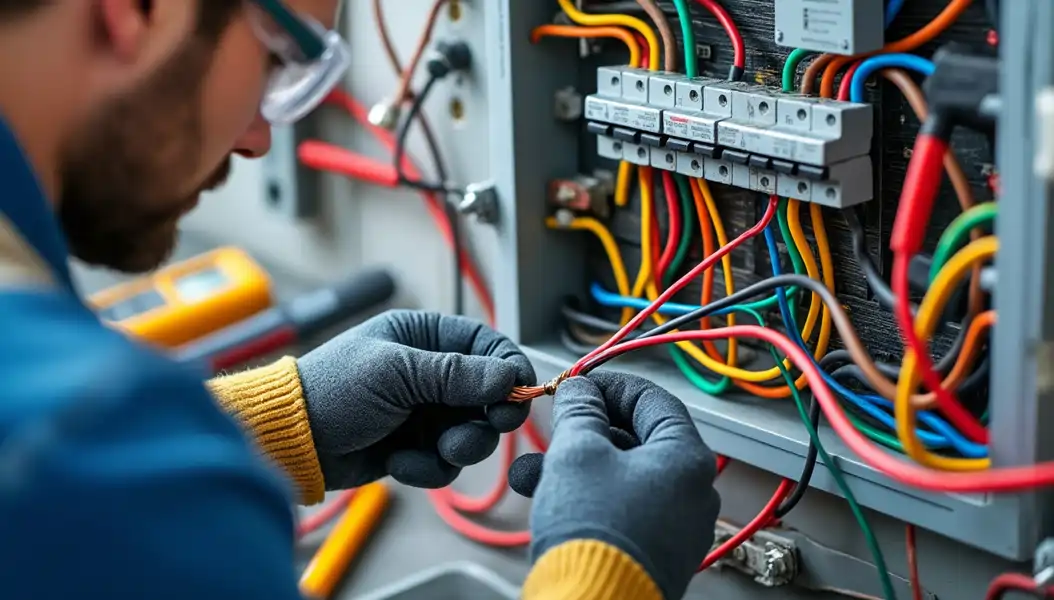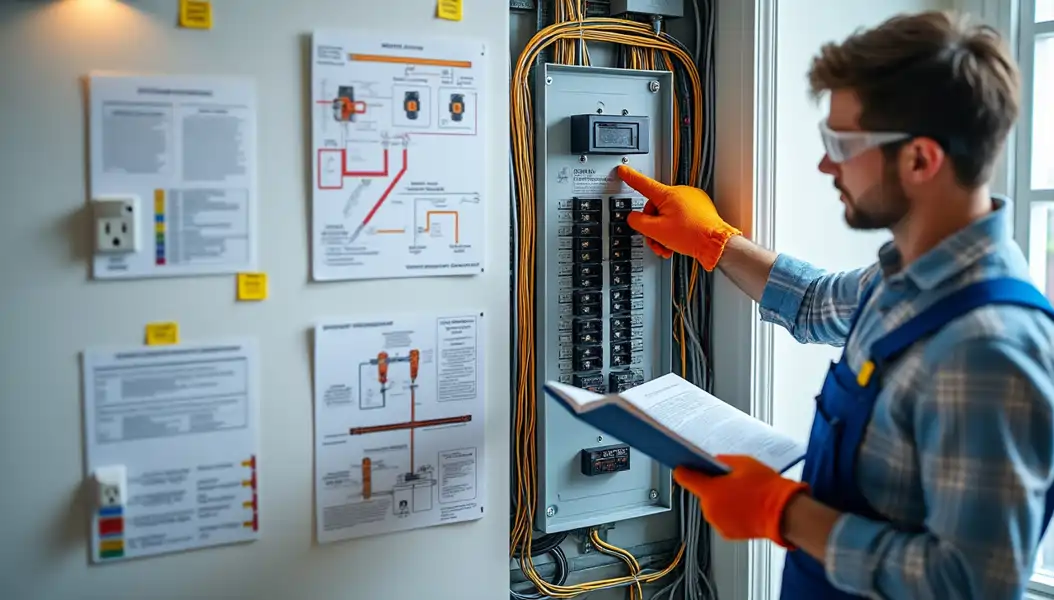
Planning an electrical installation doesn't have to be scary or complicated. I've helped thousands of homeowners just like you make smart choices about their home's wiring setup.
Want to know the best part? You can save big money by understanding the basics first!
Many folks think they need to leave everything to the pros. That's not true. While you'll definitely need certified electricians for the actual work, getting involved in the planning stage is both safe and smart.
Think of it like planning a road trip. You want to know where you're going before you start driving. The same goes for your home's electrical setup. By mapping out your needs and understanding simple concepts, you'll avoid costly mistakes and get exactly what you want.
Best of all, good planning helps you spot money-saving opportunities that many people miss. Let's make your electrical project a success!
Understanding Your Home's Electrical Ecosystem

Want to know something crazy? Your home uses more power today than homes did in the 1990s - a lot more!
Think of your home's electrical system like a busy highway. More cars (devices) need more lanes (power) to run smoothly. Today's homes power everything from smartphones to smart fridges.
Most homes need at least 200 amps now. That's double what worked fine just 20 years ago! Your Netflix binges, phone charging, and air conditioning all add up.
Here's when we use the most power:
- Morning rush (6-9 AM): Everyone's getting ready
- Evening peak (5-8 PM): Cooking, TV, heating/cooling
- Weekend afternoons: Laundry, cleaning, entertainment
Getting ready for tomorrow means thinking bigger today. Smart homes need smart power! Consider these must-haves:
- Extra circuits for future gadgets
- Dedicated lines for home office gear
- Surge protection throughout
Smart Integration Planning
Let's make your home work smarter, not harder! Start with the basics - where do you want control? Light switches, thermostats, and security cameras are great first steps.
Power matters more than ever with smart stuff. Your Ring doorbell, Nest thermostat, and Alexa all need juice 24/7. Plan for backup power to keep them running when the lights go out.
Energy monitoring is like having a fitness tracker for your home. Simple systems start at $100, while pro setups can spot power hogs instantly.
| Device Type | Daily Power Use | Monthly Cost |
|---|---|---|
| Smart Hub | 2-3 watts | $0.20 |
| Video Doorbell | 4-5 watts | $0.35 |
| Smart Thermostat | 1-2 watts | $0.15 |
| Security Cameras | 4-6 watts each | $0.40 each |
Remember: Smart homes need reliable power. A good electrical foundation makes everything else work like magic!
Pre-Installation Strategy for Maximum Efficiency
Want to know a secret? Planning your home's electrical setup before installation can save you thousands in the long run!
Let's start with your room-by-room needs. Grab a notepad and walk through each space in your home. Count every device, light, and appliance you'll use. Trust me - this simple step makes a huge difference.
Think about your daily routines. Do you love cooking with multiple appliances? Maybe you've got a home office packed with electronics? Knowing these patterns helps plan your power needs perfectly.
Here's a quick power-needs checklist:
- Kitchen appliances (especially those energy-hungry ones!)
- Entertainment systems
- Home office equipment
- Bathroom electronics
- Outdoor lighting
- Future additions
Now, let's talk smart energy moves. Installing LED lights might cost more upfront, but they'll slash your bills like crazy. And here's a cool trick: plan your outlet placement around natural light zones. This way, you'll rely less on artificial lighting during the day.
Budget-wise, follow this simple rule: allocate 40% for materials, 40% for labor, and keep 20% as a safety net. I've seen countless projects go smoother with this split.
| Room Type | Recommended Circuit Count | Typical Power Load |
|---|---|---|
| Kitchen | 3-4 dedicated circuits | 3,500-4,500 watts |
| Living Room | 2-3 circuits | 1,500-2,000 watts |
| Bedroom | 1-2 circuits | 1,000-1,500 watts |
| Home Office | 2 dedicated circuits | 2,000-2,500 watts |
When planning your circuit layout, think zones. Keep your high-power appliances (like your fridge and oven) on separate circuits. This prevents overloading and those annoying circuit breaker trips.
For living spaces, create zones based on activity. Your TV area might need more outlets than your reading nook. Think about where you'll place furniture and plan accordingly.
Remember those energy-saving tricks I mentioned? Here's the game-changer: position your windows strategically. Natural light isn't just free - it's the best kind of lighting you can get. Place your most-used spaces where they'll catch the most daylight.
Professional Collaboration Roadmap
Want to know a secret? Working with electrical contractors doesn't have to be scary. Let me show you how to make it super easy.
First things first - call your electrical contractor early. I mean really early. Like, before you even think about moving walls or buying appliances. They'll help you dodge costly mistakes.
Here's what you need before calling them:
- A rough sketch of your space
- A list of electrical things you want
- Your budget range
- Ideal timeline
Getting your paperwork ready is like packing for a trip - you need everything in order. Grab these basics:
- Floor plans (even hand-drawn ones work)
- List of appliances with power needs
- Local building codes
- Insurance documents
Now, let's talk timing. Think of your project like a recipe - everything needs to happen in the right order. Most home electrical projects take 2-7 days, depending on size.
| Project Type | Timeline | Pre-work Needed |
|---|---|---|
| Basic Rewiring | 2-3 days | Clear access to walls |
| Full Home Update | 5-7 days | Empty rooms |
| New Construction | 3-4 weeks | Building shell ready |
Quality checks are super important. Your contractor will test everything twice - first when installing, then again at the end. It's like double-checking your homework, but way more important.
Think of testing like a safety net. Your contractor will check voltage, connections, and safety features. They'll make sure everything works perfectly before they leave.
Remember: good contractors always explain what they're testing and why. If something seems off, just ask. It's your home, and you deserve to know what's happening.
Beyond Basic Installation: Future-Proofing Your Investment
Want to know a secret? Smart homeowners don't just think about today's electrical needs - they plan for tomorrow too!
Let's get your home ready for the future. First up, you'll want to prep for renewable energy. Think of it like leaving an empty parking spot in your garage for that electric car you might buy later. Adding a few extra circuits and connection points now makes it super easy to plug in solar panels or a home battery system later.
Planning for expansion is like buying kids' shoes - you always want a little room to grow. Leave some empty spots in your breaker box. Add a few extra outlets in key spots. Trust me, your future self will thank you when you don't have to tear up walls to add that home office or gaming room.
Here's what smart planning looks like:
- Pre-wire for solar panel connections
- Install larger electrical panels than currently needed
- Add conduit pipes for future wiring
- Place extra junction boxes in strategic spots
Now, about keeping everything running smoothly. Setting up a maintenance schedule is like getting regular oil changes for your car. It keeps small problems from becoming big headaches.
Real-time monitoring is your new best friend. Think of it as a fitness tracker for your home's electricity. You can spot energy hogs, catch problems early, and save money on bills.
| Future-Proof Feature | Benefit | Typical Cost Savings |
|---|---|---|
| Smart Monitoring | 15-20% lower energy bills | $300-400/year |
| Solar-Ready Setup | 40-60% reduced installation costs | $2,000-3,000 |
| Expandable Panel | No upgrade costs later | $1,500-2,000 |
Install some simple performance tracking tools now. They'll help you spot patterns, fix inefficiencies, and keep your system running like a well-oiled machine. Modern monitoring apps make it as easy as checking the weather on your phone.
Remember: A little forward thinking today saves big bucks tomorrow. Plus, you'll avoid the headache of major upgrades down the road.
Planning your electrical installation is easier than you might think. With the right knowledge and professional help, you can create a safe and efficient electrical system that meets all your needs.
Want to know the best part? A well-planned electrical setup can save you money for years to come.
Remember to think about how you'll use electricity in each room. Keep track of your power usage and make smart choices about where to place outlets and fixtures. And don't forget to plan for the future - you might want to add solar panels or smart home features later.
Working with trusted pros like us at Kercher Electric LLC makes the whole process smoother. We'll help you make choices that work for your home and budget.
Ready to get started with your electrical installation? Give us a call at (541) 948-5119. We're here to help make your home safer and more energy-efficient, one wire at a time.

Founder & Master Electrician
Matt Kercher has been a resident of Bend, Oregon since 1977 and started in the electrical trade in 1994. He became a supervisor electrician in 2008 and founded Kercher Electric LLC. With over 25 years of experience, Matt provides expert electrical services throughout Central Oregon. A proud father of 3 and grandfather of 6, he enjoys spending time with family and riding sand machines on the Oregon sand dunes when not delivering top-quality electrical solutions to residential and commercial clients.
Related Posts

Top Commercial Electrical Services Bend Oregon
Looking for reliable commercial electrical services in Bend, Oregon? You're in the right place. Our local experts know exactly what your business need...

Top Bend Oregon Contractors for Your Next Project
Looking for trusted Bend Oregon contractors for your next commercial project? You're in the right place.

Expert Industrial Power Outage Repair Bend Oregon
When your industrial power goes out in Bend, Oregon, you need fast, reliable repair service. I've helped hundreds of local businesses get back up and


